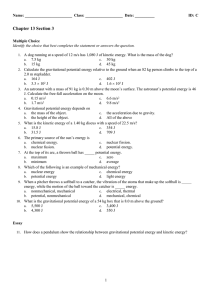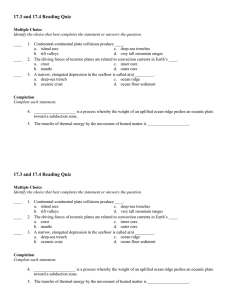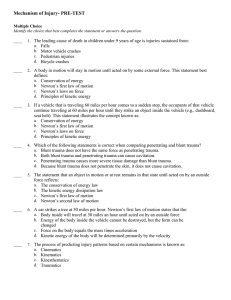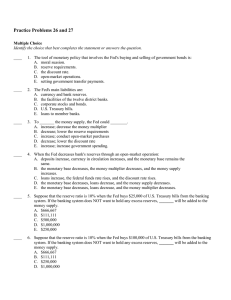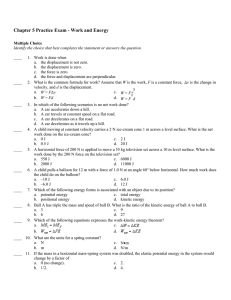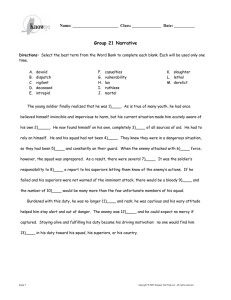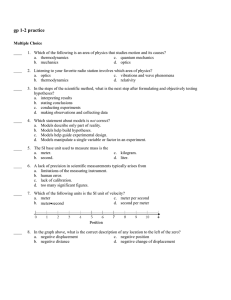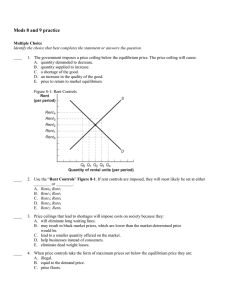Exam Review Questions
Anuncio
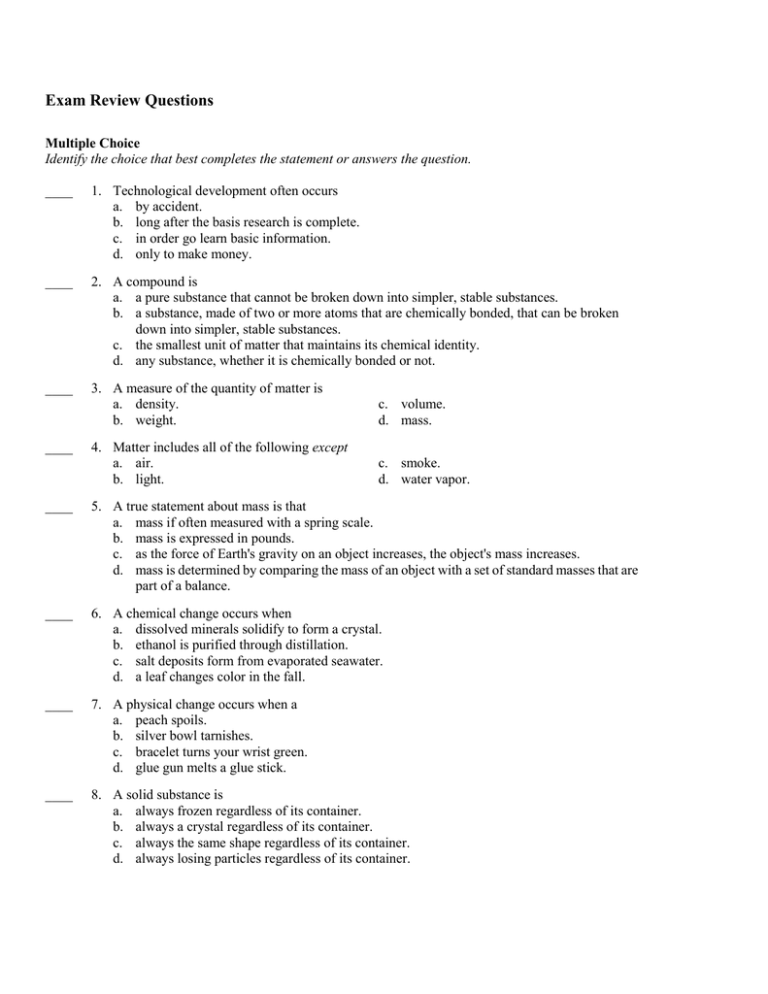
Exam Review Questions Multiple Choice Identify the choice that best completes the statement or answers the question. ____ 1. Technological development often occurs a. by accident. b. long after the basis research is complete. c. in order go learn basic information. d. only to make money. ____ 2. A compound is a. a pure substance that cannot be broken down into simpler, stable substances. b. a substance, made of two or more atoms that are chemically bonded, that can be broken down into simpler, stable substances. c. the smallest unit of matter that maintains its chemical identity. d. any substance, whether it is chemically bonded or not. ____ 3. A measure of the quantity of matter is a. density. b. weight. c. volume. d. mass. 4. Matter includes all of the following except a. air. b. light. c. smoke. d. water vapor. ____ ____ 5. A true statement about mass is that a. mass if often measured with a spring scale. b. mass is expressed in pounds. c. as the force of Earth's gravity on an object increases, the object's mass increases. d. mass is determined by comparing the mass of an object with a set of standard masses that are part of a balance. ____ 6. A chemical change occurs when a. dissolved minerals solidify to form a crystal. b. ethanol is purified through distillation. c. salt deposits form from evaporated seawater. d. a leaf changes color in the fall. ____ 7. A physical change occurs when a a. peach spoils. b. silver bowl tarnishes. c. bracelet turns your wrist green. d. glue gun melts a glue stick. ____ 8. A solid substance is a. always frozen regardless of its container. b. always a crystal regardless of its container. c. always the same shape regardless of its container. d. always losing particles regardless of its container. ____ 9. The only pure substance listed below is a. bread dough. b. vinegar (5% acetic acid). c. vitamin C (ascorbic acid). d. seawater. ____ 10. A mixture is a. a combination of pure substances bonded chemically. b. any substance with a uniform composition. c. a blend of any two or more kinds of matter, as long as each maintains its own unique properties. d. any group of elements that are chemically bonded to one another. ____ 11. A homogeneous mixture is also called a. chemically bonded. b. a compound. c. a solution. d. a solute. ____ 12. Metalloids are often a. unreactive. b. semiconductors. c. lanthanides. d. from outer space. ____ 13. Which of these statements does not describe a measurement standard? a. Measurement standards avoid ambiguity. b. Measurement standards must be unchanging. c. A standard can be easily changed to suit the experiment. d. Confusion is eliminated when the correct measurement is applied. ____ 14. Which of these statements about units of measurement is not true? a. A unit compares what is being measured with a previously defined quantity. b. A unit is usually preceded by a number. c. Measurements can be compared without knowing their units. d. The choice of unit depends on the quantity being measured. ____ 15. Which of these metric units is used to measure mass? a. m c. g b. mm d. L ____ 16. Which of these is the abbreviation for the SI base unit of time? a. hr c. sec b. h d. s ____ 17. Which of these statements about mass is true? a. Mass is expressed in pounds or newtons. b. Mass is usually measured with a spring scale. c. The mass of an object depends on the force of gravity acting on it. d. The mass of an object is determined by comparing it to an object of known mass. ____ 18. The density of pure diamond is 3.5 g/cm3. What is the volume of a diamond with a mass of 0.25 g? a. 0.071 cm3 c. 3.75 cm3 b. 0.875 cm3 d. 14 cm3 ____ 19. A measurement that closely agrees with an accepted value is best described as a. precise. c. significant. b. reproducible. d. accurate. ____ 20. The number of significant figures in the measurement 2010 cm is a. 1. c. 3. b. 2. d. 4. ____ 21. When 64.4 is divided by 2.00, the correct number of significant figures in the result is a. 1. c. 4. b. 3. d. 6. ____ 22. The capacity of a Florence flask is 250 mL. Its capacity in liters expressed in scientific notation is a. 2.5 10–2 L. c. 2.5 101 L. –1 b. 2.5 10 L. d. 2.5 102 L. ____ 23. Two variables are inversely proportional if their ____ has a constant value. a. sum c. product b. difference d. quotient ____ 24. If two or more compounds are composed of the same two elements, the ratio of the masses of one element that combine with a fixed mass of the other element is a simple whole number. This is a statement of the law of a. conservation of mass. c. multiple proportions. b. mass action. d. definite composition. ____ 25. According to the law of conservation of mass, when sodium, hydrogen, and oxygen react to form a compound, the mass of the compound is ____ the sum of the masses of the individual elements. a. equal to c. less than b. greater than d. either greater than or less than ____ 26. The principles of atomic theory recognized today were conceived by a. Avogadro. c. Dalton. b. Bohr. d. Rutherford. ____ 27. Which of the following is not part of Dalton's atomic theory? a. Atoms cannot be divided, created, or destroyed. b. The number of protons in an atom is its atomic number. c. In chemical reactions, atoms are combined, separated, or rearranged. d. All matter is composed of extremely small particles called atoms. ____ 28. Experiments with cathode rays led to the discovery of the a. proton. c. neutron. b. nucleus. d. electron. ____ 29. A positively charged particle with mass 1.673 10–24 g is a(n) a. proton. c. electron. b. neutron. d. positron. ____ 30. A nuclear particle that has about the same mass as a proton, but with no electrical charge, is called a(n) a. nuclide. c. electron. b. neutron. d. isotope. ____ 31. Protons within a nucleus are attracted to each other by a. the nuclear force. c. their energy levels. b. opposite charges. d. electron repulsion. ____ 32. Most of the volume of an atom is occupied by the a. nucleus. c. electrons. b. nuclides. d. protons. ____ 33. The most common form of hydrogen has a. no neutrons. b. one neutron. c. two neutrons. d. three neutrons. ____ 34. The nucleus of deuterium contains one proton and a. two neutrons. c. no neutrons. b. one neutron. d. two electrons. ____ 35. The relative atomic mass of an atom can be found by comparing the mass of the atom to the mass of a. one atom of carbon-12. c. a proton. b. one atom of hydrogen-1. d. uranium-235. ____ 36. Carbon-14 (atomic number 6), the radioactive nuclide used in dating fossils, has a. 6 neutrons. c. 10 neutrons. b. 8 neutrons. d. 14 neutrons. ____ 37. The mass of a sample containing 3.5 mol of silicon atoms (atomic mass 28.0855 amu) is approximately a. 28 g. c. 72 g. b. 35 g. d. 98 g. ____ 38. The frequency of electromagnetic radiation is measured in waves/second, or a. nanometers. c. hertz. b. quanta. d. joules. ____ 39. The wave model of light does not explain a. the frequency of light. b. the continuous spectrum. c. interference. d. the photoelectric effect. ____ 40. The Bohr model of the atom was an attempt to explain hydrogen's a. density. c. mass. b. flammability. d. line-emission spectrum. ____ 41. Bohr's theory helped explain why a. electrons have negative charge. b. most of the mass of the atom is in the nucleus. c. excited hydrogen gas gives off certain colors of light. d. atoms combine to form molecules. ____ 42. Which energy-level change shown in the diagram below emits the highest energy? a. b. c. d. an electron moving from E6 to E5 an electron moving from E2 to E4 an electron moving from E2 to E3 an electron moving from E2 to E1 ____ 43. The size and shape of an electron cloud are most closely related to the electron's a. charge. c. spin. b. mass. d. energy. ____ 44. According to the quantum theory of an atom, in an orbital a. an electron's position cannot be known precisely. b. an electron has no energy. c. electrons cannot be found. d. electrons travel around the nucleus on paths of specific radii. ____ 45. The quantum number that indicates the position of an orbital about the three axes in space is the a. principal quantum number. b. angular momentum quantum number. c. magnetic quantum number. d. spin quantum number. ____ 46. The spin quantum number indicates that the number of possible spin states for an electron in an orbital is a. 1. c. 3. b. 2. d. 5. ____ 47. The letter designations for the first four sublevels with the maximum number of electrons that can be accommodated in each sublevel are a. s:2, p:4, d:6, and f:8. b. s:1, p:3, d:5, and f:7. c. s:2, p:6, d:10, and f:14. d. s:1, p:2, d:3, and f:4. ____ 48. One main energy level can hold 18 electrons. What is n? a. c. 6 b. 3 d. 18 ____ 49. The main energy level that can hold only two electrons is the a. first. c. third. b. second. d. fourth. ____ 50. The statement that no two electrons in the same atom can have the same four quantum numbers is a. the Pauli exclusion principle. c. Bohr's law. b. Hund's rule. d. the Aufbau principle. ____ 51. Which of the following rules requires that each of the p orbitals at a particular energy level receive one electron before any of them can have two electrons? a. Hund's rule c. the Aufbau principle b. the Pauli exclusion principle d. the quantum rule ____ 52. Which of the following lists atomic orbitals in the correct order they are filled according to the Aufbau principle? a. 1s 2s 2p 3s 4s 3p 3d 4p 5s b. 1s 2s 2p 3s 3p 4s 3d 4p 5s c. 1s 2s 2p 3s 3p 4s 4p 3d 4d d. 1s 2s 2p 3s 3p 3d 4s 4p 5s ____ 53. The element with electron configuration 1s2 2s2 2p6 3s2 3p2 is a. Mg (Z = 12). c. S (Z = 16). b. C (Z = 6). d. Si (Z = 14). ____ 54. The electron notation for aluminum (atomic number 13) is a. 1s2 2s2 2p3 3s2 3p3 3d1. b. 1s2 2s2 2p6 3s2 2d1. c. 1s2 2s2 2p6 3s2 3p1. d. 1s2 2s2 2p9. ____ 55. If the s and p sublevels of the highest main energy level of an atom are filled, how many electrons are in this main energy level? a. 2 c. 16 b. 8 d. 32 ____ 56. The periodic table a. permits the properties of an element to be predicted before the element is discovered. b. will be completed with element 118. c. has been of little use to chemists since the early 1900s. d. was completed with the discovery of the noble gases. ____ 57. What are the elements with atomic numbers from 58 to 71 called? a. the lanthanides c. the actinides b. the noble gases d. the alkali metals ____ 58. Barium, atomic number 56, is the fifth element in Group 2. What is the atomic number of radium, the next element in Group 2? a. 64 c. 88 b. 74 d. 103 ____ 59. In Period 3 there are 8 elements. What sublevel(s) is (are) being filled? a. s c. s and p b. s and d d. d and f ____ 60. The electron configurations of the noble gases from neon to radon in the periodic table make these elements part of the a. f block. c. s block. b. d block. d. p block. ____ 61. The elements in Group 1 are also known as the a. alkali metals. c. Period 1 elements. b. rare-earth series. d. actinide series. ____ 62. The most reactive group of the nonmetals is the a. lanthanides. c. halogens. b. transition elements. d. noble gases. ____ 63. The first member of the noble gas family, whose highest energy level consists of an octet of electrons, is a. helium. c. neon. b. argon. d. krypton. ____ 64. Compared to the alkali metals, the alkaline-earth metals a. are less reactive. b. have lower melting points. c. are less dense. d. combine more readily with nonmetals. ____ 65. As the atomic number of the metals of Group 1 increases, the ionic radius a. increases. c. remains the same. b. decreases. d. cannot be determined. ____ 66. Which is the best reason that the atomic radius generally increases with atomic number in each group of elements? a. The nuclear charge increases. b. The number of neutrons increases. c. The number of occupied energy levels increases. d. A new octet forms. ____ 67. As you move left to right in Period 4 from gallium through bromine, atomic radii a. generally increase. c. do not change. b. generally decrease. d. vary unpredictably. ____ 68. The electrons available to be lost, gained, or shared when atoms form compounds are called a. ions. c. d electrons. b. valence electrons. d. electron clouds. ____ 69. Which groups in the main group have lower electronegativity than d-block elements? a. groups 1 and 2 c. groups 17 and 18 b. groups 13 through 18 d. groups 13 through 17 ____ 70. The electrons involved in the formation of a chemical bond are called a. dipoles. c. Lewis electrons. b. s electrons. d. valence electrons. ____ 71. Atoms naturally move a. toward high potential energy. b. toward low potential energy. c. toward less stability. d. away from each other. ____ 72. What are shared in a covalent bond? a. ions b. Lewis structures c. electrons d. dipoles ____ 73. Which of the following is not an example of a molecular formula? a. H2O c. NH3 b. B d. O2 ____ 74. The energy released when a covalent bond forms is the difference between zero and the a. maximum potential energy. c. minimum potential energy. b. kinetic energy of the atom. d. bond length expressed in nanometers. ____ 75. What group of elements satisfies the octet rule without forming compounds? a. halogen c. alkali metal b. noble gas d. alkaline-earth metal ____ 76. In drawing a Lewis structure, each nonmetal atom except hydrogen should be surrounded by a. 2 electrons. c. 8 electrons. b. 4 electrons. d. 10 electrons. ____ 77. The chemical formula for an ionic compound represents the a. number of atoms in each molecule. b. number of ions in each molecule. c. ratio of the combined ions present in a sample. d. total number of ions in the crystal lattice. ____ 78. The forces of attraction between molecules in a molecular compound are a. stronger than the forces among formula units in ionic bonding. b. weaker than the forces among formula units in ionic bonding. c. approximately equal to the forces among formula units in ionic bonding. d. zero. ____ 79. Compared with nonmetals, the number of valence electrons in metals is generally a. smaller. c. about the same. b. greater. d. almost triple. ____ 80. In metallic bonds, the mobile electrons surrounding the positive ions are called a(n) a. Lewis structure. c. electron cloud. b. electron sea. d. dipole. ____ 81. Which best explains the observation that metals are malleable and ionic crystals are brittle? a. their chemical bonds c. their enthalpies of vaporization b. their London forces d. their net change ____ 82. Iodine monochloride (ICl) has a higher boiling point than bromine (Br2) partly because iodine monochloride is a(n) a. nonpolar molecule. c. metal. b. polyatomic ion. d. polar molecule. ____ 83. How many atoms of fluorine are present in a molecule of carbon tetrafluoride, CF4? a. 1 c. 4 b. 2 d. 5 ____ 84. The formula for carbon dioxide, CO2, can represent a. one molecule of carbon dioxide. b. 1 mol of carbon dioxide molecules. c. the combination of 1 atom of carbon and 2 atoms of oxygen. d. all of the above. ____ 85. Name the compound Ni(ClO3)2. a. nickel(II) chlorate b. nickel(II) chloride c. nickel(II) chlorite d. nickel(II) peroxide ____ 86. Name the compound KClO3. a. potassium chloride b. potassium trioxychlorite c. potassium chlorate d. hypochlorite ____ 87. Name the compound SO3. a. sulfur trioxide b. silver trioxide c. selenium trioxide d. sodium trioxide ____ 88. Name the compound N2O3. a. dinitrogen oxide b. nitrogen trioxide c. nitric oxide d. dinitrogen trioxide ____ 89. What is the formula for silicon dioxide? a. SO2 b. SiO2 c. Si2O d. S2O ____ 90. What is the oxidation number of sulfur in SO2? a. 0 c. +2 b. +1 d. +4 ____ 91. What is the oxidation number of oxygen in CO2? a. –4 c. 0 b. –2 d. +4 ____ 92. How many oxygen atoms are there in 0.500 mol of CO2? a. 6.02 1023 c. 15.9994 23 b. 3.01 10 d. 11.0 ____ 93. What is the percentage composition of CF4? a. 20% C, 80% F b. 13.6% C, 86.4% F c. 16.8% C, 83.2% F d. 81% C, 19% F ____ 94. The percentage composition of sulfur in SO2 is about 50%. What is the percentage of oxygen in this compound? a. 25% c. 75% b. 50% d. 90% ____ 95. What is the mass percentage of OH– in Ca(OH)2? a. 45.9% c. 75% b. 66.6% d. 90.1% ____ 96. The empirical formula may not represent the actual composition of a unit of a(n) a. ionic compound. c. salt. b. molecular compound. d. crystal. ____ 97. What is the empirical formula for a compound that is 53.3% O and 46.7% Si? a. SiO c. Si2O b. SiO2 d. Si2O3 ____ 98. The molecular formula for vitamin C is C6H8O6. What is the empirical formula? a. CHO c. C3H4O3 b. CH2O d. C2H4O2 ____ 99. A compound's empirical formula is NO2. If the formula mass is 92 amu, what is the molecular formula? a. NO c. NO4 b. N2O2 d. N2O4 ____ 100. A compound's empirical formula is CH3. If the formula mass is 30 amu, what is the molecular formula? a. CH3 c. C2H6 b. CH4 d. C3H9 Completion Complete each statement. 101. A chemistry student is studying the formation of quartz crystals. She is studying ____________________ chemistry. 102. Applied research is often performed to find the answer to a particular ____________________. 103. Gravel is an example of a(n) ____________________ mixture. Use a periodic table to answer the following questions. 104. Find the symbol for the element neon. ____________________ 105. Find the symbol for the element iodine. ____________________ 106. In which period can you find the element iron? ____________________ 107. In which group can you find the element neon? ____________________ 108. Find the symbol for the element argon. ____________________ 109. The name and formula for the compound formed by strontium ions and sulfite ions are ____________________. 110. The oxidation numbers for each atom in are ____________________. Short Answer 111. Why can a gas fill the entire volume of its container? 112. Show how SI units for volume and density are derived from SI base units for length and mass. 113. Distinguish between mass and weight. 114. Distinguish between precision and accuracy. 115. Give the location and relative charge of a proton. 116. Why do chemists work with moles instead of individual atoms? 117. What do quantum numbers describe? 118. How does the figure below illustrate Hund's rule? 119. How does the figure above illustrate the Pauli exclusion principle? 120. Differentiate between an ionic compound and a molecular compound. Essay 121. Explain the significance of Avogadro's constant, 6.022 1023. What is the relationship between it and the molar mass of oxygen, 16.00 g/mol? 122. Explain nuclear charge and how it affects the general trend in radii of atoms of elements going from left to right across a period in the periodic table. 123. HO and H2O2 are examples of the empirical and molecular formula of a compound, respectively. Explain the relationship between these two types of formulas. Problem 124. How many moles of platinum are equivalent to 1.20 1024 atoms? 125. How many moles of iron are equivalent to 1.11 1025 atoms? 126. Determine the mass in grams of 5.00 mol of oxygen. The molar mass of oxygen is 16.00 g/mol. 127. Determine the number of moles of helium in 10.0 g of helium. The molar mass of helium is 4.00 g/mol. Use the periodic table below to answer the following questions. 128. Draw the orbital diagram for argon. 129. Write the noble-gas electron configuration represented in the orbital diagram below. 130. What element's orbital diagram is shown in the figure below? 131. Draw a Lewis structure for carbon disulfide, CS2. 132. Draw a Lewis structure for the nitrate ion, . Use VSEPR theory to predict its molecular geometry. 133. The molar mass of iron is 55.85 g/mol, the molar mass of silicon is 28.08 g/mol, and the molar mass of oxygen is 16.00 g/mol. Calculate the molar mass of iron(II) silicate, Fe2SiO4. Exam Review Questions Answer Section MULTIPLE CHOICE 1. ANS: OBJ: 2. ANS: OBJ: 3. ANS: OBJ: 4. ANS: OBJ: 5. ANS: OBJ: 6. ANS: OBJ: 7. ANS: OBJ: 8. ANS: OBJ: 9. ANS: OBJ: 10. ANS: OBJ: 11. ANS: OBJ: 12. ANS: OBJ: 13. ANS: OBJ: 14. ANS: OBJ: 15. ANS: OBJ: 16. ANS: OBJ: 17. ANS: OBJ: 18. ANS: B 3 B 1 D 1 B 1 D 1 D 2 D 2 C 3 C 5 C 5 C 5 B 4 C 1 C 1 C 2 D 2 D 3 A PTS: 1 STA: SWK.12.5 PTS: 1 DIF: I REF: 1 DIF: II REF: 2 PTS: 1 DIF: I REF: 2 PTS: 1 DIF: I REF: 2 PTS: 1 DIF: III REF: 2 PTS: 1 DIF: II REF: 2 PTS: 1 DIF: II REF: 2 PTS: STA: PTS: STA: PTS: STA: PTS: STA: PTS: STA: PTS: STA: PTS: STA: PTS: STA: PTS: STA: PTS: STA: DIF: II REF: 2 DIF: III REF: 2 DIF: II REF: 2 DIF: II REF: 2 DIF: II REF: 3 DIF: I REF: 2 DIF: I REF: 2 DIF: I REF: 2 DIF: I REF: 2 DIF: I REF: 2 REF: 2 OBJ: 4 1 PS.9.6 1 PS.9.9 1 PS.9.9 1 PS.9.9 1 PS.9.4 1 SI.12.5 1 SI.12.5 1 SI.12.5 1 SI.12.5 1 SI.12.5 Solution: PTS: 1 DIF: III STA: 19. ANS: OBJ: 20. ANS: OBJ: 21. ANS: OBJ: 22. ANS: OBJ: 23. ANS: OBJ: 24. ANS: OBJ: 25. ANS: OBJ: 26. ANS: OBJ: 27. ANS: OBJ: 28. ANS: OBJ: 29. ANS: OBJ: 30. ANS: OBJ: 31. ANS: OBJ: 32. ANS: OBJ: 33. ANS: OBJ: 34. ANS: OBJ: 35. ANS: OBJ: 36. ANS: OBJ: 37. ANS: SI.12.2 D 1 C 2 B 3 B 4 C 5 C 1 A 1 C 2 B 2 D 1 A 3 B 3 A 3 C 4 A 1 B 1 A 2 B 3 D PTS: STA: PTS: STA: PTS: STA: PTS: STA: PTS: STA: PTS: STA: PTS: STA: PTS: STA: PTS: STA: PTS: STA: PTS: STA: PTS: STA: PTS: STA: PTS: STA: PTS: STA: PTS: STA: PTS: STA: PTS: STA: 1 DIF: SI.12.5 1 DIF: SI.12.5 1 DIF: SI.12.5 1 DIF: SI.12.5 1 DIF: SI.12.5 1 DIF: PS.9.7 1 DIF: PS.9.7 1 DIF: PS.9.26 1 DIF: PS.9.26 1 DIF: PS.12.15 1 DIF: PS.9.1 1 DIF: PS.9.1 1 DIF: PS.9.1 1 DIF: PS.9.1 1 DIF: PS.11.1 1 DIF: PS.11.1 1 DIF: PS.9.2 | PS.11.1 1 DIF: PS.9.2 | PS.11.1 DIF: PTS: STA: PTS: STA: PTS: STA: III 1 PS.9.18 1 PS.12.13 1 PS.12.14 I REF: 3 II REF: 3 III REF: 3 III REF: 3 I REF: 3 II REF: 1 II REF: 1 I REF: 1 I REF: 1 I REF: 2 I REF: 2 I REF: 2 II REF: 2 I REF: 2 I REF: 3 I REF: 3 I REF: 3 III REF: 3 Solution: PTS: 38. ANS: OBJ: 39. ANS: OBJ: 40. ANS: OBJ: 1 C 1 D 3 D 4 REF: 3 DIF: I OBJ: 5 REF: 1 DIF: II REF: 1 DIF: I REF: 1 41. ANS: OBJ: 42. ANS: OBJ: 43. ANS: OBJ: 44. ANS: OBJ: 45. ANS: OBJ: 46. ANS: OBJ: 47. ANS: OBJ: 48. ANS: OBJ: 49. ANS: OBJ: 50. ANS: OBJ: 51. ANS: OBJ: 52. ANS: OBJ: 53. ANS: OBJ: 54. ANS: OBJ: 55. ANS: OBJ: 56. ANS: OBJ: 57. ANS: OBJ: 58. ANS: OBJ: 59. ANS: OBJ: 60. ANS: OBJ: 61. ANS: OBJ: 62. ANS: OBJ: 63. ANS: OBJ: 64. ANS: OBJ: 65. ANS: C 4 C 4 D 2 A 3 C 4 B 4 C 5 B 1 A 1 A 2 A 2 B 3 D 3 C 3 B 3 A 2 A 2 C 4 C 1 D 2 A 4 C 4 C 4 A 4 A PTS: STA: PTS: STA: PTS: STA: PTS: STA: PTS: STA: PTS: STA: PTS: STA: PTS: STA: PTS: STA: PTS: STA: PTS: STA: PTS: STA: PTS: STA: PTS: STA: PTS: STA: PTS: STA: PTS: STA: PTS: STA: PTS: STA: PTS: STA: PTS: STA: PTS: STA: PTS: STA: PTS: STA: PTS: 1 PS.12.14 1 PS.12.14 1 PS.12.14 1 PS.12.14 1 PS.12.12 1 PS.12.12 1 PS.12.12 1 PS.12.12 1 PS.12.12 1 PS.12.12 1 PS.12.12 1 PS.12.12 1 PS.12.12 1 PS.12.12 1 PS.12.12 1 PS.9.4 1 PS.9.4 1 PS.9.4 1 PS.9.4 1 PS.9.4 1 PS.9.4 1 PS.9.4 1 PS.9.4 1 PS.9.4 1 DIF: II REF: 1 DIF: I REF: 1 DIF: I REF: 2 DIF: I REF: 2 DIF: I REF: 2 DIF: II REF: 2 DIF: II REF: 2 DIF: III REF: 3 DIF: I REF: 3 DIF: I REF: 3 DIF: I REF: 3 DIF: II REF: 3 DIF: II REF: 3 DIF: II REF: 3 DIF: I REF: 3 DIF: I REF: 1 DIF: I REF: 1 DIF: II REF: 1 DIF: II REF: 2 DIF: I REF: 2 DIF: I REF: 2 DIF: I REF: 2 DIF: I REF: 2 DIF: II REF: 2 DIF: II REF: 3 OBJ: 66. ANS: OBJ: 67. ANS: OBJ: 68. ANS: OBJ: 69. ANS: OBJ: 70. ANS: OBJ: 71. ANS: OBJ: 72. ANS: OBJ: 73. ANS: OBJ: 74. ANS: OBJ: 75. ANS: OBJ: 76. ANS: OBJ: 77. ANS: OBJ: 78. ANS: OBJ: 79. ANS: OBJ: 80. ANS: OBJ: 81. ANS: OBJ: 82. ANS: OBJ: 83. ANS: OBJ: 84. ANS: OBJ: 85. ANS: OBJ: 86. ANS: OBJ: 87. ANS: OBJ: 88. ANS: OBJ: 89. ANS: OBJ: 2 C 2 B 2 B 3 A 4 D 1 B 2 C 3 B 1 C 2 B 3 C 4 C 1 B 4 A 1 B 1 A 3 D 5 C 1 D 1 A 3 C 3 A 4 D 4 B 5 STA: PTS: STA: PTS: STA: PTS: STA: PTS: STA: PTS: STA: PTS: STA: PTS: STA: PTS: STA: PTS: STA: PTS: STA: PTS: STA: PTS: STA: PTS: STA: PTS: STA: PTS: STA: PTS: STA: PTS: STA: PTS: STA: PTS: STA: PTS: STA: PTS: STA: PTS: STA: PTS: STA: PTS: STA: PS.9.4 1 DIF: PS.9.4 1 DIF: PS.9.4 1 DIF: PS.9.4 1 DIF: PS.9.4 1 DIF: PS.9.7 | PS.12.1 1 DIF: PS.9.7 | PS.12.1 1 DIF: PS.9.7 | PS.12.1 1 DIF: PS.9.7 | PS.12.1 1 DIF: PS.9.7 | PS.12.1 1 DIF: PS.9.7 | PS.12.1 1 DIF: PS.9.7 | PS.12.1 1 DIF: PS.9.7 | PS.12.1 1 DIF: PS.9.7 | PS.12.1 1 DIF: PS.9.7 | PS.12.1 1 DIF: PS.9.7 | PS.12.1 1 DIF: PS.9.7 | PS.12.1 1 DIF: PS.12.1 1 DIF: PS.12.1 1 DIF: PS.12.1 1 DIF: PS.12.1 1 DIF: PS.12.1 1 DIF: PS.12.1 1 DIF: PS.12.1 1 DIF: PS.12.1 II REF: 3 II REF: 3 I REF: 3 II REF: 3 I REF: 1 I REF: 1 I REF: 1 II REF: 2 I REF: 2 I REF: 2 I REF: 2 I REF: 3 I REF: 3 I REF: 4 I REF: 4 I REF: 4 II REF: 5 II REF: 1 II REF: 1 III REF: 1 III REF: 1 II REF: 1 II REF: 1 II REF: 1 90. ANS: D OBJ: 2 91. ANS: B OBJ: 2 92. ANS: A Solution: PTS: STA: PTS: STA: PTS: 1 STA: PS.12.1 93. ANS: B Solution: 1 PS.9.5 1 PS.9.5 DIF: III REF: 2 DIF: III REF: 2 DIF: III REF: 3 OBJ: 3 PTS: 1 STA: PS.12.1 94. ANS: B OBJ: 4 95. ANS: A Solution: DIF: III REF: 3 OBJ: 4 PTS: 1 STA: PS.12.1 DIF: II REF: 3 PTS: 1 STA: PS.12.1 96. ANS: B OBJ: 1 97. ANS: B Solution: DIF: III REF: 3 OBJ: 4 PTS: 1 STA: PS.12.1 DIF: I REF: 4 PTS: 1 STA: PS.12.1 98. ANS: C DIF: III REF: 4 OBJ: 2 PTS: 1 DIF: III REF: 4 OBJ: 3 99. ANS: D Solution: STA: PS.12.1 PTS: 1 STA: PS.12.1 100. ANS: C Solution: DIF: III REF: 4 OBJ: 4 PTS: 1 STA: PS.12.1 DIF: III REF: 4 OBJ: 4 DIF: II REF: 1 OBJ: 2 PTS: 1 DIF: II STA: SWK.12.5 103. ANS: heterogeneous REF: 1 OBJ: 3 PTS: 1 STA: PS.9.9 104. ANS: Ne DIF: II REF: 2 OBJ: 5 PTS: 1 STA: PS.9.1 105. ANS: I DIF: I REF: 3 OBJ: 2 PTS: 1 STA: PS.9.1 106. ANS: 4 DIF: I REF: 3 OBJ: 2 PTS: 1 STA: PS.9.4 107. ANS: 18 DIF: I REF: 3 OBJ: 3 PTS: 1 STA: PS.9.4 DIF: I REF: 3 OBJ: 3 COMPLETION 101. ANS: inorganic PTS: 1 102. ANS: problem 108. ANS: Ar PTS: 1 DIF: I STA: PS.9.1 109. ANS: strontium sulfite, SrSO3 REF: 3 OBJ: 2 PTS: 1 STA: PS.12.1 110. ANS: N –3, H +1 DIF: III REF: 1 OBJ: 3 DIF: III REF: 2 OBJ: 2 PTS: 1 STA: PS.9.5 SHORT ANSWER 111. ANS: Gas particles do not attract one another, and can easily and quickly move from one place to another. PTS: 1 DIF: I REF: 2 OBJ: 3 STA: PS.9.6 112. ANS: V = m3 or any correct conversion of meters cubed to a volume unit AND d = kg/m3 or any correct conversion of kilograms divided by meters cubed to a density unit. PTS: 1 DIF: II REF: 2 OBJ: 2 STA: SI.12.5 113. ANS: Mass is the amount of matter in something. OR Mass is a measure of an object’s inertia. Weight is a measure of the gravitational pull on an object. PTS: 1 DIF: II REF: 2 OBJ: 3 STA: SI.12.5 114. ANS: Precision is how close a set of measurements of the same quantity are. Accuracy is how close a measurement is to the true value. PTS: 1 DIF: II REF: 3 OBJ: 1 STA: SI.12.5 115. ANS: A proton is a subatomic particle with a positive charge that is located in the nucleus of an atom. PTS: 1 DIF: I REF: 2 OBJ: 3 STA: PS.9.1 116. ANS: A mole is a collection of atoms that is large enough to measure. A single atom or even a million atoms is too small to measure directly with a balance. PTS: 1 DIF: II REF: 3 OBJ: 4 117. ANS: Three of the quantum numbers describe the location of an electron, and the fourth gives its spin. PTS: 1 DIF: II REF: 2 OBJ: 4 STA: PS.12.12 118. ANS: According to Hund's rule, the arrangement of electrons with the maximum number of unpaired electrons is the most stable arrangement. PTS: 1 DIF: III REF: 3 OBJ: 2 STA: PS.12.12 119. ANS: According to the Pauli exclusion principle, no two electrons can have the same set of four quantum numbers. Therefore, no more than two electrons can occupy an orbital, and these two must have opposite spins. PTS: 1 DIF: III REF: 3 OBJ: 2 STA: PS.12.12 120. ANS: Atoms in a molecular compound share electrons to achieve stability. Atoms in an ionic compound gain or lose electrons to form ions, which combine so that the number of positive and negative charges is equal. PTS: 1 DIF: II STA: PS.9.7 | PS.12.1 REF: 3 OBJ: 1 ESSAY 121. ANS: Avogadro's constant is the number of particles in 1 mol of a substance. Because the molar mass of oxygen atoms is 16.00 g/mol, the mass of 1 mol, or 6.022 1023, oxygen atoms is 16.00 g. PTS: 1 DIF: II REF: 3 OBJ: 4 122. ANS: Nuclear charge is the attraction an atomic nucleus has on the electrons surrounding it. As you move from left to right across a period, the atomic number increases, and therefore the number of protons in the nucleus increases. The more protons within a nucleus, the greater is the nuclear charge. A greater nuclear charge pulls the electrons closer to the nucleus, decreasing the atomic radius. PTS: 1 DIF: II REF: 3 OBJ: 2 STA: PS.9.4 123. ANS: The empirical formula is related to the molecular formula by the relationship x(empirical formula) = molecular formula. The x is a whole-number factor by which the subscripts in the empirical formula must be multiplied. The product is the correct molecular formula. In this case, x = 2. PTS: 1 STA: PS.12.1 PROBLEM DIF: I REF: 4 OBJ: 4 124. ANS: 1.99 mol Pt Solution: PTS: 1 125. ANS: 18.4 mol Fe DIF: III REF: 3 OBJ: 5 DIF: III REF: 3 OBJ: 5 DIF: III REF: 3 OBJ: 5 PTS: 1 128. ANS: DIF: III REF: 3 OBJ: 5 PTS: 1 129. ANS: [Ne] 3s2 3p4 DIF: III OBJ: 4 STA: PS.12.12 PTS: 1 STA: PS.12.12 130. ANS: fluorine DIF: III REF: 3 OBJ: 3 PTS: 1 STA: PS.12.12 131. ANS: DIF: III REF: 3 OBJ: 3 Solution: PTS: 1 126. ANS: 80.0 g O Solution: PTS: 1 127. ANS: 2.50 mol He Solution: PTS: 1 DIF: III STA: PS.9.7 | PS.12.1 132. ANS: REF: 3 OBJ: 5 trigonal-planar PTS: 1 DIF: III REF: 3 OBJ: 5 STA: PS.9.7 | PS.12.1 133. ANS: 203.78 g/mol Fe2SiO4 Solution: (2 55.85 g/mol Fe) + (28.08 g/mol Si) + (4 16.00 g/mol O) = 203.78 g/mol Fe2SiO4 PTS: 1 STA: PS.12.1 DIF: III REF: 3 OBJ: 1
